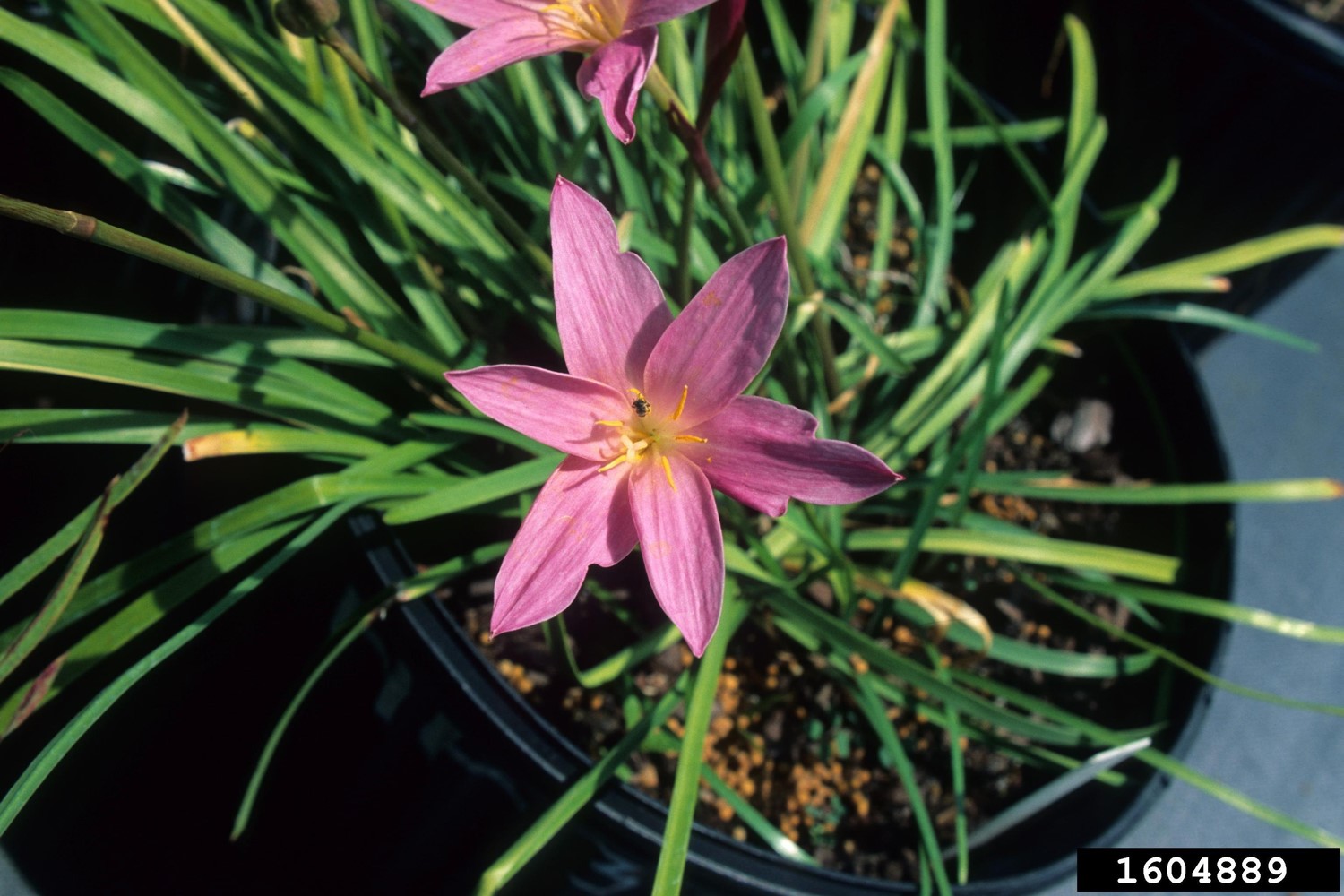
by Mary Salinas | Sep 2, 2016
Florida is home to many gorgeous and desirable native plant species. One to consider for your landscape is the rainlily, Zephyranthes and Habranthus spp. They are easy to care for and are bothered by few pests.

Cuban rainlily, Zephyranthes rosea. Photo: John Ruter, University of Georgia, Bugwood.org
As the name implies, rainlilies do thrive when getting consistent rain or watering. A good soaking rain event will result in blooms within a few days. This love for moisture makes them perfect for rain gardens.
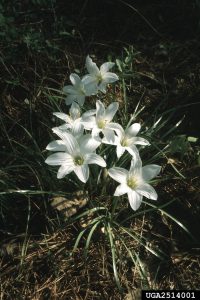
Atamasco rainlily, Zephyranthes atamasco. Photo: Jerry A. Payne, USDA Agricultural Research Service, Bugwood.org.
Plant the bulbs or transplants in full sun to part shade in moist but well-drained fertile soil. Let them be for many years in order to form large impressive clumps and that is when they flower the best. You can also separate the clumps every few years to colonize new areas and pass along to others. After the plants bloom they will reliably set seed that you can collect to start rainlilies in other parts of your garden. However, the seeds are viable for only a short time so you should plant them immediately.
For sources of plant material, try your local nursery that tends to carry native plants or through online sources.
For more information:
Rainlily, Zephyranthes and Habranthus spp.: Low Maintenance Flowering Bulbs for Florida Gardens
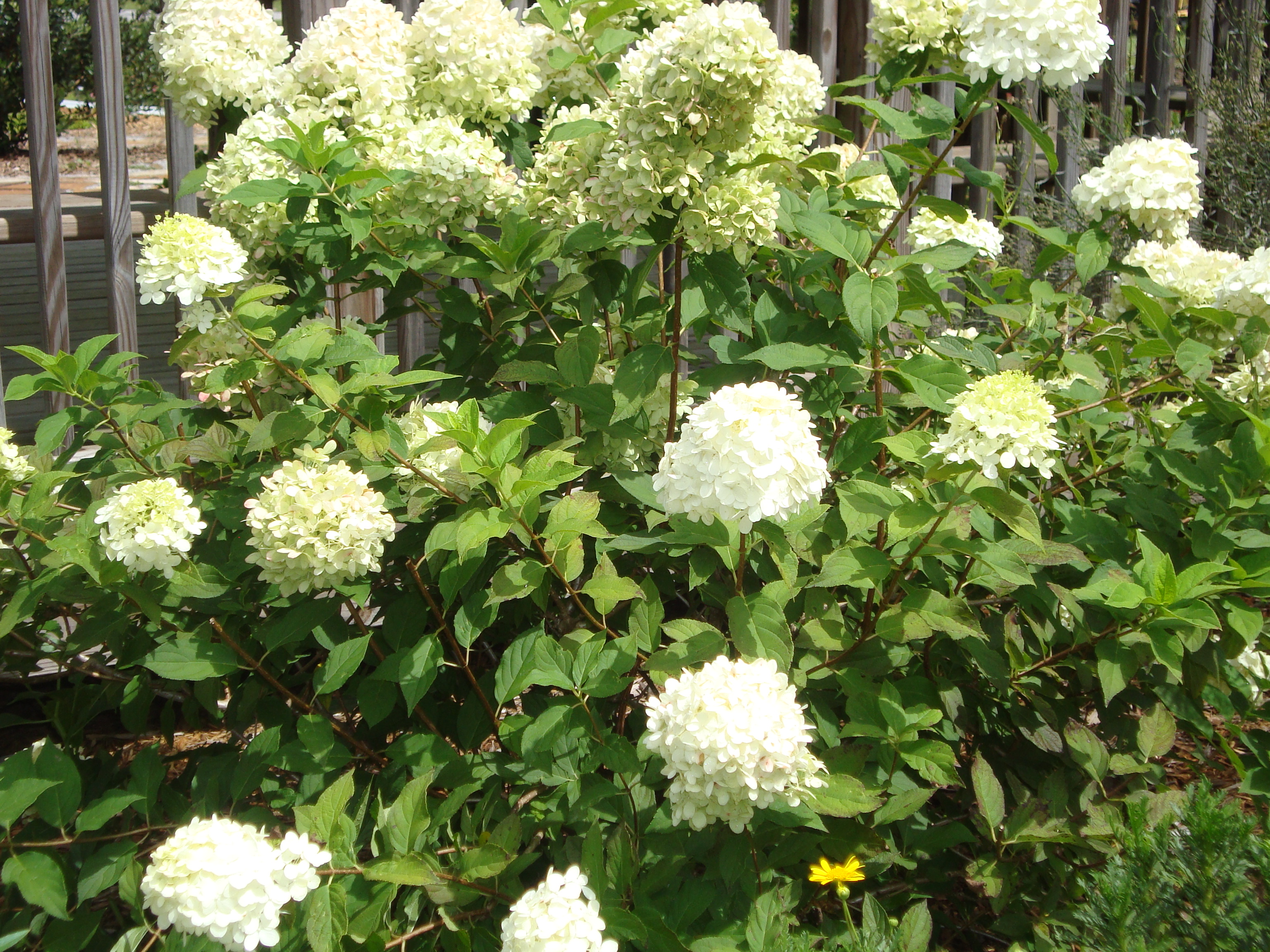
by Beth Bolles | Jun 8, 2016
Gardeners love to share plants. My yard, like many of my gardener friends, is filled with plant gifts that were started from a cutting or division of a favorite plant. These two methods of growing new plants is fairly easy once you learn the techniques and allows gardeners a way to save a little money and grow more plants for their yard, special community projects, or even some fundraising events.
In our enthusiasm over a favorite plant, gardeners must be aware that we are not allowed to propagate certain plants from cuttings or division. Many of our ornamental plants, especially newer introductions are patented plants. These are seen as ‘premium’ plants that will hopefully be in demand by the public. The plant developer or nursery invests in the patent in hopes that the plant will become the next must have ornamental. Only businesses or individuals with authorization from the patent holder are able to asexual propagate these plants since the Plant Patent Act protects these new varieties for 20 years from the date of introduction.
So if you bought a beautiful Limelight hydrangea (Hydrangea paniculata ‘Limelight’ Plant patent #12,874) for your yard, you may not take a cutting to start a new plant, even if it is only for yourself.
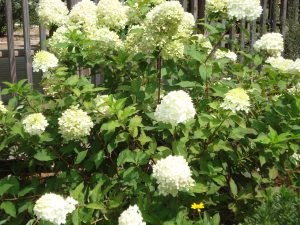
If you want more than one Limelight Hydrangea, you must purchase it. Photo by Beth Bolles
When you visit the nursery, look on the plant label which will often indicate if the plant is patented. You may also look online to see if plant has a patent.
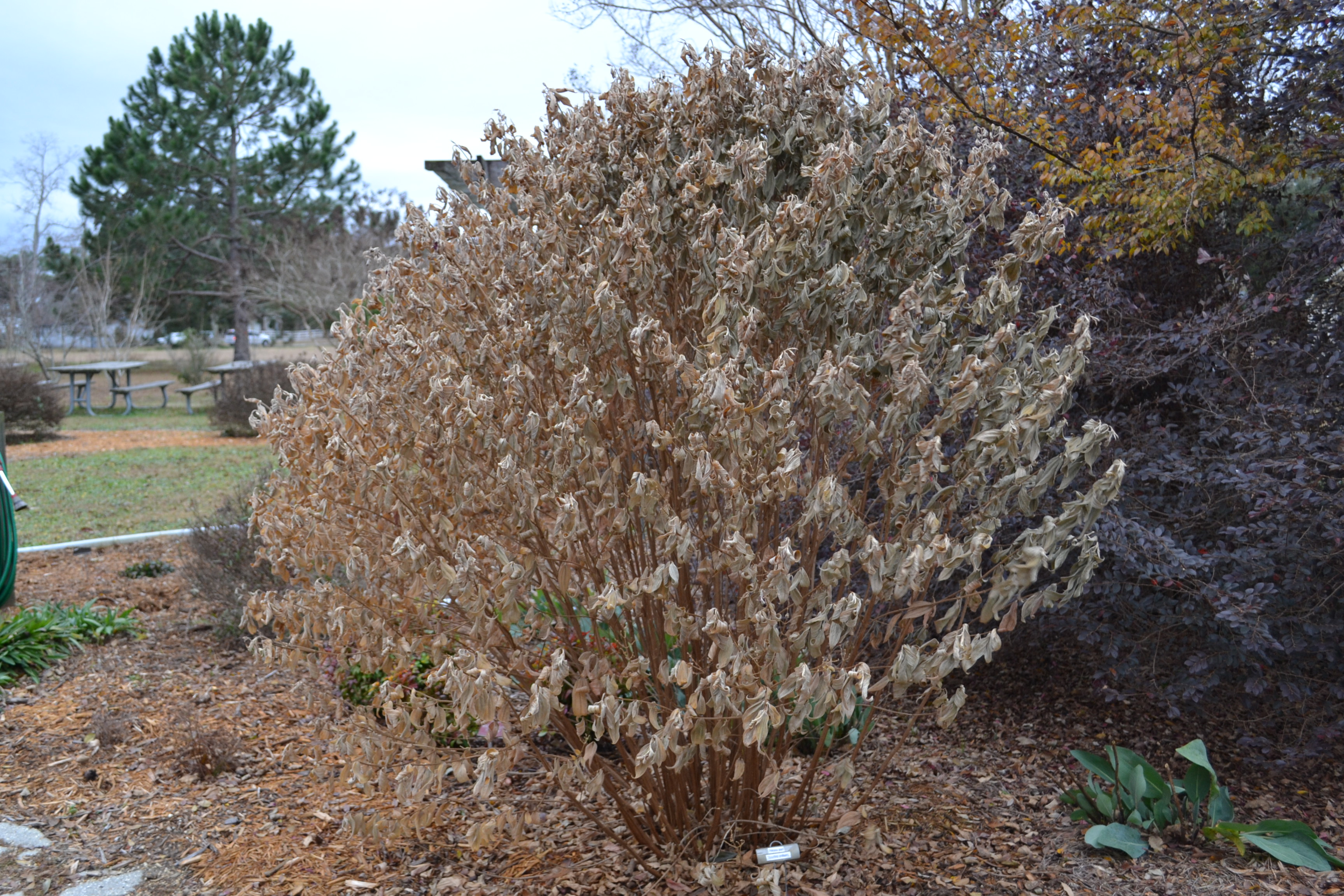
by Matthew Orwat | Feb 10, 2016
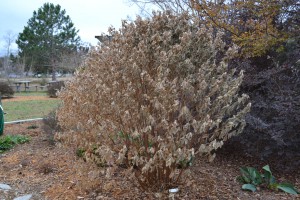
Image Credit: Beth Bolles
Although it is quite cold outside right now, spring is just around the corner. Many of us have perennials we enjoyed all summer and fall, and have been faced with their ugly dead stalks all winter. Perennials that are meant to die to the ground each winter look ugly and decayed after the first frost. For many perennials, the stalks have been left up and allowed to slowly die, allowing nutrients to be slowly translocated to the root system.
Many perennials, such as hibiscus species, hydrangea, salvia species, firebush (Hamelia patens), rudbeckia, echinacea, lantana and others still have a large amount of starch stored in their branches, even after the first frost. Although it was very tempting to remove these unattractive reminders of the beautiful spring gardening season, hopefully you waited to allow the starch to translocate (move) down to the root system.
Now through early March is the time to remove those unsightly dead branches to living tissue. To determine if there is “life” left in those burned and singed stems, just scratch off the top layer of the stem. If any nutrients remain in the stem, it will be green or yellow where the scratch was made. Another good way to determine if it is a good time to cut perennials back, since coastal and inland locales differ climactically, is to observe the beginning of new growth and trim at that time. If it is brown it’s dead, cut it back!
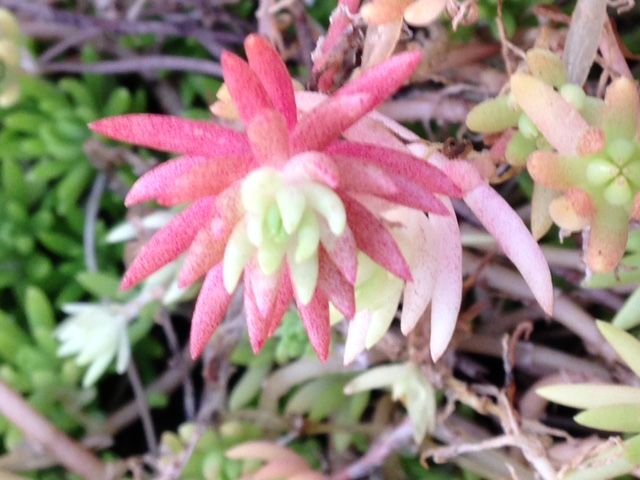
by Julie McConnell | Dec 30, 2015
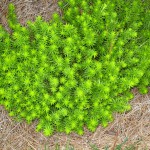 Sedum rupestre ‘Angelina’ is an evergreen perennial that adds some pizazz to winter landscapes. This low growing plant performs well in sunny, well-drained spots in the landscape but will also tolerate some shade. In the summer, the foliage is a brilliant chartreuse but after a few cold snaps it takes on a coppery bronze tinge that brightens up winter landscapes.
Sedum rupestre ‘Angelina’ is an evergreen perennial that adds some pizazz to winter landscapes. This low growing plant performs well in sunny, well-drained spots in the landscape but will also tolerate some shade. In the summer, the foliage is a brilliant chartreuse but after a few cold snaps it takes on a coppery bronze tinge that brightens up winter landscapes.
Angelina sedum is an easy to grow groundcover that contrasts nicely with deep greens, burgundy, or black foliage. It grows well along the ground or in containers where it may drape down the sides. It roots where the stems touch the ground, but is not aggressive and can be easily divided and transplanted into new garden sites or shared with friends.
Small, delicate yellow flowers appear in the late spring or early summer but the plants are mostly grown for foliage texture and color.
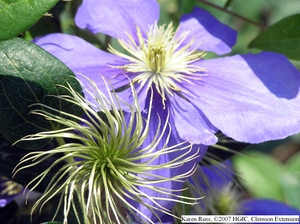
by Matt Lollar | Dec 16, 2015
With the cotton harvest coming to an end, it’s not unusual to see cotton littered on the sides of the road. You may also think you see it hanging in the trees, but you will be pleasantly surprised to find a hidden gem. Woodbine (Clematis virginiana) and coastal virgin’s bower (Clematis catesbyana) are two native species of clematis that can be found wrapped around trees in the Panhandle. They have finished flowering for the year and you will notice their showy seed lint hanging in the trees.
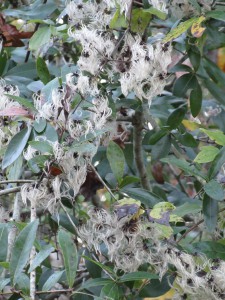
Clematis growing in an oak tree. Photo Credit: Matt Lollar, UF/IFAS
Clematis leaves are compound, consisting of 3 to 5 leaflets, dark green and glossy with toothed edges. The vines are typically 1/2 inch in diameter and can grow to 20 feet. The flowers are much smaller than those of cultivated varieties found at garden centers. Flowers are white with prominent stamens. Clematis catesbyana and Clematis virginiana have similar flowers, but the flowers of C. virginiana are fragrant.
Clematis species grow well in partial shade to full shade. Native plants are often found entwined in the forest understory near streams or ponds where soil conditions are moist. Garden varieties grow well with their roots in moist, shaded soil and their leaves and flowers in the sun. They are often seen growing on a trellis or on a fence.
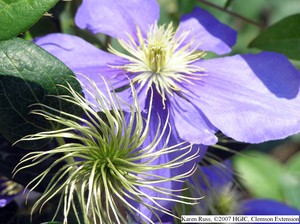
Clematis ‘General Sikorski’. Photo Credit: Karen Russ, Clemson University
It is important to note that some species of clematis are invasive. Sweet autumn clematis or Japanese clematis (Clematis terniflora) is a vigorous invasive species that was once popular in southern gardens. This species has similar characteristics to C. catesbyana and C. virginiana, but its leaflets have smooth edges. You should develop a control strategy if Japanese clematis is found in your garden. For control options, please visit EDIS – Japanese Clematis.












